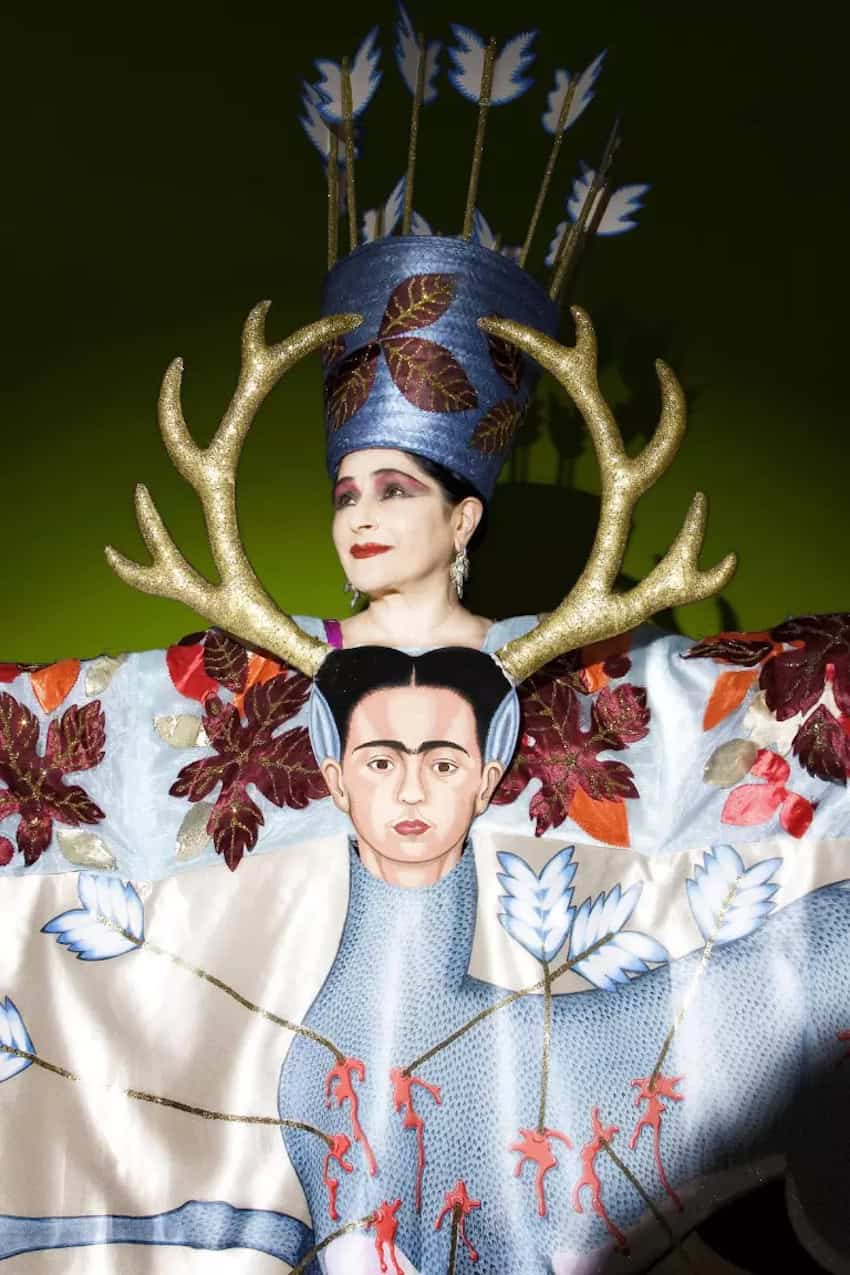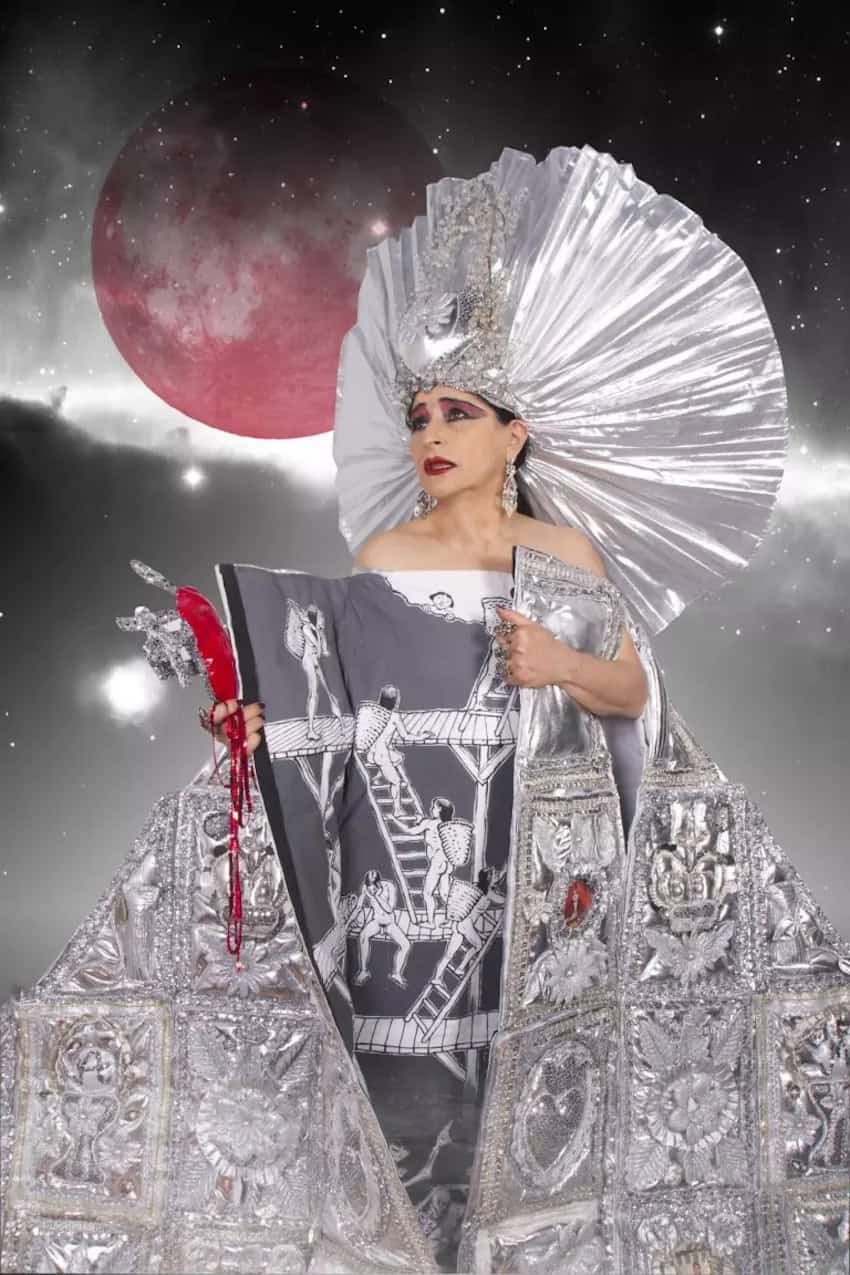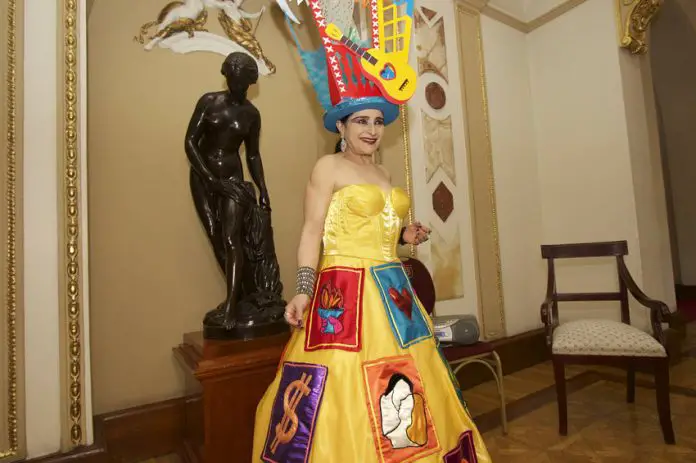Astrid Hadad explodes onstage as a brilliant, dazzling star — which is exactly what she is — in the world of cabaret. From her costumes to her elaborate eye makeup, enough is never enough. She takes it further until it’s over the top. Sometimes called the Lady Gaga of Mexico, she refers to herself as the “Lady Gaga of Nixtamal” — the processed maize used to make corn tortillas — demonstrating her sense of humor. Her performances are laced with irony, cynicism and wicked wit. She is part performance artist and part satirist; her performances onstage are like a camp asteroid.
Born in 1957 to Lebanese parents in Chetumal, Quintano Roo, Hadad studied political science and journalism at the University of Veracruz. She later moved to Mexico City, where she studied theater at the National Autonomous University (UNAM). Her breakthrough role as a performer was in 1984 in Jesusa Rodríguez’s production of “Dona Giovanni.” She then began performing in nightclub cabaret, her performances interwoven with folklore that pay homage to Mexican culture while simultaneously skewering it.

Her style is influenced by revues, the theatrical entertainment also known as the “low-class genre.” Popular in the first four decades of the 20th century, revues served as a “stage newspaper” to inform people on current events and criticism and were the most important disseminator of music and popular culture. Revue — known in Spanish as el teatro de la revista — was very popular in Mexico, but its criticism of the government led to numerous performers being exiled to Cuba.
Hdad’s dramatic eye makeup comes from German Expressionism and movies she watched as a young girl. She learned to apply the makeup in drama school; with small eyes and a small face, she decided she needed the dramatic eye makeup to be seen in the back row of the theater. After trying it out the first time, she decided it would become her onstage trademark. In real life she wears very little makeup and dresses more conservatively – she doesn’t mix her public stage persona with her private life.
Hadad is also a social activist. Her performances challenge issues of colonialism, race, gender, oppression and social inequality. Every show refers to gender freedom and women’s freedoms. She writes, produces and promotes her own work, and most of her work challenges cultural and societal norms of gender roles in Mexican society.
Throughout her more than four-decade career, she has supported the LGBTQ+ community. She loves them, and they love her right back. Drag queens imitate her — she admires them as many have surpassed her with their costumes and makeup — and some people believe Hadad herself is a drag queen, which amuses her to no end.

Many of Hadad’s performances are legendary. She appropriates well-known Mexican cultural icons, straps them to her body or dress and reconfigures their meaning onstage, drawing from Mexico’s rich legacy of history and culture: Aztec and Maya symbolism, revolutionary heroes, Indigenous folk art, exuberant plants and flowers and even Catholic saints. She plays with these stereotypes to create comedy and satire creating her own surrealistic cabaret full of irony, biting wit and campy humor. She also, however, takes on corruption, violence, machismo, corporate exploitation and imperialism. Nothing escapes her wicked wit: she’s not afraid to skewer the sacred cows of Mexican culture, including hypocrisy, which she lampoons with back-handed compliments and deftly delivered asides.
Hadad’s acts are often outrageous, but she is also a gifted singer, skillfully belting out those long, deep notes on mournful songs like the best Mexican balladeers. Her deep, throaty voice complements the large headdresses and bawdy jokes. Each act is a package of costumes, songs and commentary all melding together seamlessly to tell a story.
Hadad’s performances give people glimpses of Mexico’s history. One act tells the story of how Our Lady of Guadalupe replaced the pre-Columbian earth goddess Coatlicue. Her costume is a massive, inverted wedding cake skirt covered with skulls representing the pre-Columbian goddess with two large Aztec serpents propped against each hip and large maguey leaves fanning out behind her like the plumage of a rooster. While sweeping the floor during the performance she makes sarcastic quips like Coatlicue’s pregnancy must have been an immaculate conception because Mexican women are always busy working.
Hadad’s performances always contain numerous costumes, each more outrageous than the last. A glimmering Aztec costume in gold with a towering feather headdress and ankle rattles has been decorated with sugar skulls that glow in black light. A circus tent skirt that doubles as a puppet show with puppets decked out like Mexican revolutionaries painted on a black velvet backdrop. For Hadad, too much is never enough.

She also weaves in Mexican folk songs like “El Venadito” dedicated to the painter Frida Kahlo out of admiration. Opening the front of her dress reveals Kahlo’s ionic 1946 canvas “El venado herido” (The Wounded Deer) which shows the artist as a deer struck by arrows. Is it a bit crass? Yes, but Hadad is always testing the boundaries.
She typically performs traditional Mexican songs like “La Bamba,” but has introduced at least one original song with “Tierra Misteriosa,” a ballad of colonization that she dedicates to “the exploited people.” She sings while she opens her shimmering virginal silver gown to reveal Indigenous people toiling in mines.
Her diva-like mix of glam, camp and wicked sense of humor is popular in Mexico and the United States. She has also toured Latin America and Europe frequently, can be seen regularly at cabaret nightclubs in Mexico City, where she lives, and often performs at LGBTQ+ events. This September, she headlined the Queerraiser, a fundraiser hosted by Outsider, an Austin, Texas nonprofit that spotlights LGBTQ+ artists.
Hadad insists her performances are not political per se. Although she talks about politics and social problems, she says her acts are about entertainment in the true sense of cabaret. She does, however, hope that people reflect while being entertained and that her work will help your spirit grow, take you to other places and expand your knowledge.
At 69 years of age and more than 40 years of cabaret entertaining, Hadad is still going strong. She says her life, like everyone’s, has had its ups and downs, but she’ll die happy because she’s had a life she liked and has done what she wanted.
Sheryl Losser is a former public relations executive, researcher, writer and editor. She has been writing professionally for 35 years. She moved to Mazatlán in 2021 and works part-time doing freelance writing. She can be reached at AuthorSherylLosser@gmail.
